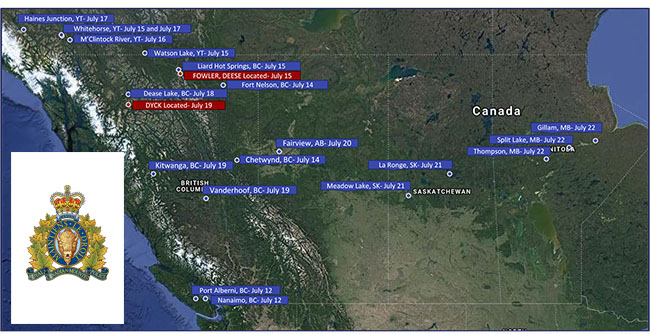Bryer Schmegelsky and Kam McLeod admitted to fatally shooting three people in northern B.C. last summer before taking part in a suicide pact.

That was one of the conclusions of the RCMP’s weeks-long investigation into the killings, which triggered a nationwide manhunt involving extensive police resources and the Canadian military.
In releasing a report on the investigation Friday, B.C. RCMP Assistant Commissioner Kevin Hackett told reporters the pair took responsibility for the murders on video without explaining their motive.
“They indicate no remorse for their actions, as well as their intentions to potentially kill others,” he said.
Schmegelsky, 18, and McLeod, 19, were initially considered missing persons in July before they became suspects in the deaths of Leonard Dyck, a University of British Columbia botany instructor, and a young couple, Australian Lucas Fowler and American Chynna Deese.
WATCH: How the northern B.C. murder suspects were linked to homicides

They were charged with second-degree murder in Dyck’s death while the manhunt was ongoing.
Authorities found the pair deceased next to two firearms near Gillam, Man. — a small, remote community roughly 1,000 km north of Winnipeg — about three weeks after the first two victims were killed.
Here’s a look at the new details that have been revealed in the case, and what questions have yet to be answered.
Why did the killing spree happen?
That’s one of the biggest questions posed by the case, but investigators say Schmegelsky and McLeod left no statement on their possible motive, and there was no evidence collected suggesting the two friends were planning a triple murder.
“We uncovered no information that predicted or forecasted the homicides that took place in northern B.C.,” Hackett said.

Get breaking National news
Neither had criminal records, but had “limited police interactions” that were unremarkable, the report stated.
READ MORE: ‘This is all preventable’: Father of B.C. murder suspect questions RCMP role in manhunt
Hackett said the deaths appear to be random crimes of opportunity. Investigators theorized that McLeod and Schmegelsky came across Lucas Fowler’s van and targeted them “for unknown reasons.”
They were found dead off Highway 97, south of the Liard River Hot Springs, on July 15.
The pair then drove to the Yukon but returned south to B.C. after experiencing trouble with their truck. According to the report, they killed Dyck in Deese Lake, B.C., and stole his vehicle, money and other items.
WATCH: Father of suspected B.C. murderer speaks about family nightmare

How did they obtain guns?
The investigation found there were two non-restricted, semi-automatic rifles used in the deaths. One gun has unclear origins — police believe it was cobbled together using various parts over several years.
The other gun was purchased on July 12 — the day the pair left their Vancouver Island town of Port Alberni, leaving family with the impression they would be travelling in search of work.
McLeod, who has a firearms’ licence, legally purchased the gun as well as 20 rounds of ammunition at a Cabela’s location in Nanaimo, B.C.
Why isn’t the RCMP releasing video evidence — and what does it show?
The RCMP said a digital camera belonging to one of the victims, Leonard Dyck, contained six short videos and three still images pertaining to the suspects.
In the videos, the two young men admit to the killings, according to investigators.
Police said they are not releasing the videos out of respect for the victims’ families, but also out of concern for public safety.
“The videos may influence or inspire other individuals to carry out a targeted act of violence, essentially creating copycat killers,” Hackett explained.
The contents of the footage was described in the report.
The first video, which is nearly a minute long, features both men confessing to the three murders and announcing plans to march to Hudson Bay, hijack a boat and travel to Europe or Africa.
In the second, also nearly a minute long, Schmegelsky says the pair have reached the Nelson River, and may have to kill themselves. McLeod agrees. Neither of them expresses remorse as they again take credit for the three killings.
The RCMP said Schmegelsky states in a third, 32-second video that he and McLeod have shaved in preparation for their deaths, and are planning to kill more people. He says they expect to be dead in a week.
A 19-second fourth video features the pair expressing their plan to die by suicide. After a six-second video believed to be unintentional, a final, 31-second video contains the suspects’ “last will and testament,” where they say they wish to be cremated.
Police said one of the three images on the camera shows Schmegelsky posing with one of the semi-automatic rifles.
What was the timeline of their travels?

The RCMP investigation has shed new light on the timeline of events in the triple murder case.
Police say the pair made it to the Yukon on July 15. They were seen at a gas station in Whitehorse two days later, then travelled back to B.C. before heading through Alberta, Saskatchewan and Manitoba.
Dyck’s Toyota RAV 4 was found burned out in Gillam on July 22.
Are they suspected in any other deaths?
Despite McLeod and Schmegelsky suggesting they would harm others, according to evidence collected by police, Hackett said investigators are satisfied there are no other victims.
With files from Sarah MacDonald and Sean Boynton, Global News












Comments